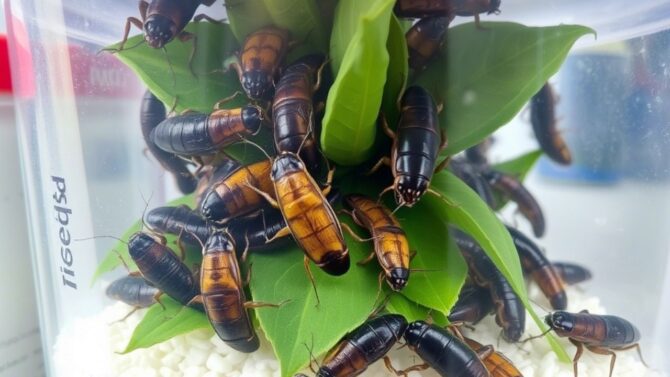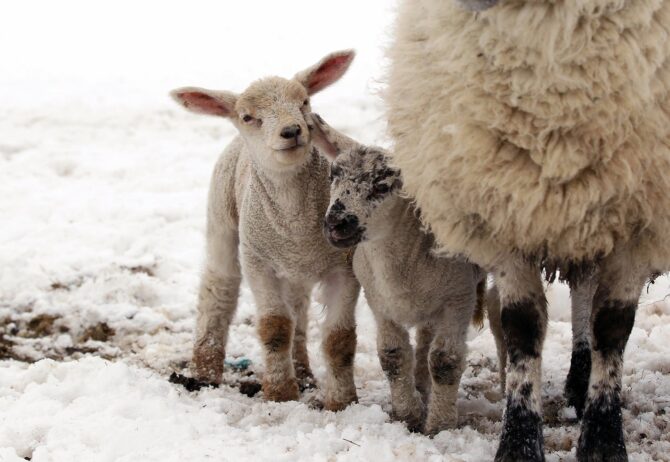Keeping live feeder insects healthy and properly stored is essential for the well-being of your pet reptiles. When stored correctly, feeder insects like Dubia roaches, mealworms, and superworms can remain nutritious and ready for feeding. However, many reptile owners face common challenges when it comes to insect storage:
- Incorrect temperature and humidity can shorten their lifespan.
- Overcrowding leads to stress and death.
- Lack of proper food and cleanliness causes health problems.
Fortunately, by following some straightforward guidelines, you can create an optimal environment for your feeder insects. In this post, we will dive into how to properly store live feeder insects to ensure they stay healthy and ready to nourish your reptile pets.
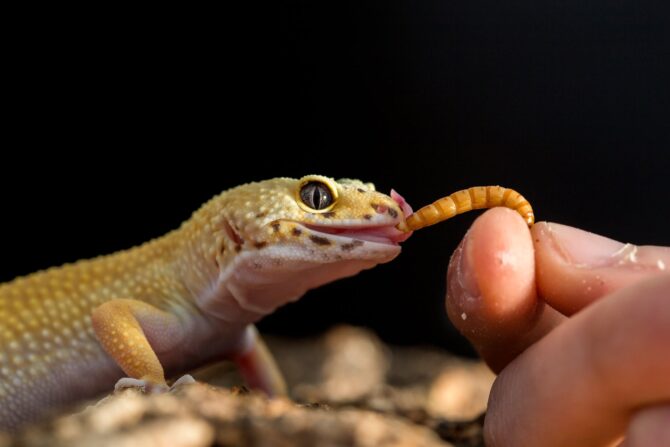
1. Maintain the Right Temperature
Each type of feeder insect thrives within a specific thermal range. Dubia roaches, known for their high protein content and ease of care, do best in temperatures ranging from 77°F to 86°F (25°C to 30°C). If the environment becomes too cold, they slow down significantly, making them less active and less nutritious. Excessive heat can cause extreme stress and may result in death. A consistent temperature is vital.
A spare room, closet, or any space in the home with stable warmth can work well. Supplementing the container with a heat mat or ceramic heat emitter will help sustain optimal conditions. Ensure the heating source doesn’t cause overheating by monitoring the temperature daily with a digital thermometer.
To care for Dubia roaches effectively, make sure to maintain a stable environment with proper humidity and ventilation, as well as offering them a nutritious diet. For superworms, mealworms, and waxworms, the same temperature range generally applies. Just make sure to place the container in a stable, warm area.
2. Provide Proper Containers
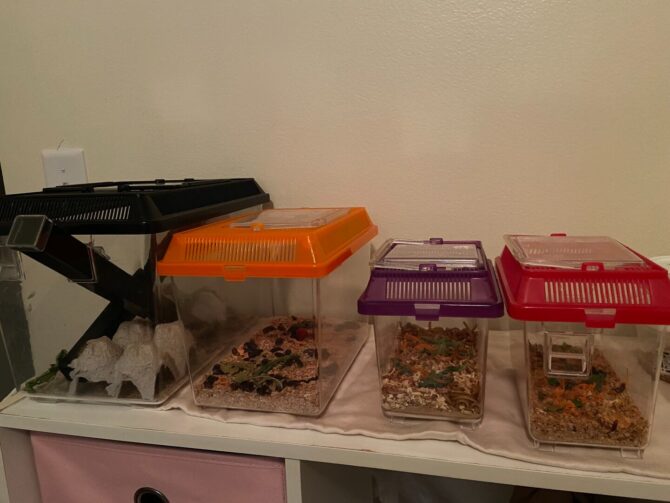
To keep your live feeder insects safe and prevent them from escaping, it’s important to store them in appropriate containers. Smooth-sided plastic or glass containers are ideal since they prevent insects from climbing out. Make sure the container has enough ventilation holes, as insects need airflow.
For Dubia roaches, you can use a plastic bin with a lid that has small ventilation holes. These bins come in various sizes, and you should choose one that suits the number of insects you’re storing.
For superworms and mealworms, plastic tubs or plastic containers with secure lids also work well. Keep the lid on, but allow for ventilation. It’s important to keep the insects safe from drafts and humidity changes as these can cause stress to them.
3. Offer Proper Bedding and Food
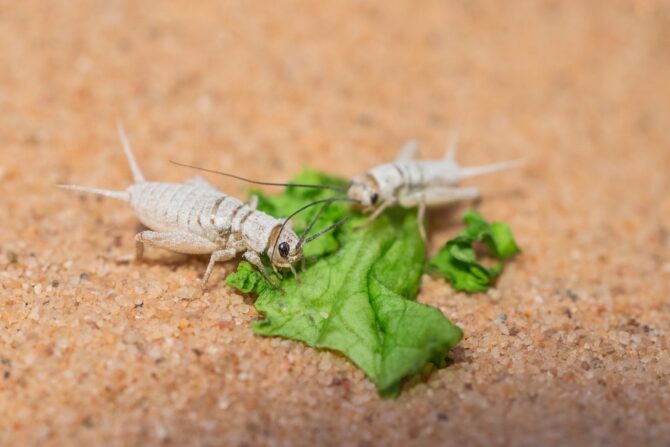
Feeder insects require clean, safe bedding and a continuous supply of food and hydration to remain healthy and nutritious for your reptile. Maintaining optimal living conditions not only supports their wellbeing but also ensures they deliver maximum nutritional benefit when consumed.
For Dubia roaches, create an environment that promotes ventilation and shelter. Bedding should consist of the following:
- Paper towels
- Egg cartons
- Shredded cardboard
These provide surface area and hiding spaces while promoting air circulation. Nutrition is equally critical. Feed them a varied diet to maintain their health and ensure nutrient transfer to your reptile. Suitable food options include:
- Dry dog food (protein-rich base)
- Fresh fruits such as apples and oranges
- Vegetables like carrots and squash
- Calcium-rich options (e.g., powdered calcium-dusted greens or commercial gut-load formulas)
Mealworms and superworms thrive on simple, starchy and moisture-rich substrates. Their bedding and diet can be combined for ease of maintenance. Offer:
- Rolled oats or wheat bran
- Carrot slices (moisture and nutrients)
- Potato chunks (longer-lasting hydration source)
4. Humidity Control

Proper humidity levels play a critical role in maintaining the health of feeder insects like Dubia roaches and superworms. These species benefit from a moderately moist environment, as it supports their metabolic processes and helps with molting.
Light misting with clean water or adding a damp (not wet) paper towel to their container can help maintain optimal moisture without turning the enclosure into a swamp.
Mold growth, bacterial proliferation, and insect death are common consequences of poor moisture management.
Excess water pooled at the bottom of the container often leads to drowned insects or encourages fly larvae to develop. Avoid standing water at all costs.
Focus instead on increasing relative humidity in a controlled, gradual way. One method includes using moisture-retaining substrates like coconut fiber that hold dampness without becoming soggy.
Humidity levels around 50% to 60% are generally effective. Use a hygrometer to monitor the conditions inside the enclosure.
These inexpensive devices are easy to find in pet supply stores and will give accurate feedback so adjustments can be made without guesswork. It’s a smart investment for any serious insect keeper.
Make sure ventilation remains adequate. Even in humid conditions, stagnant air can promote the growth of harmful fungi or bacteria. Proper airflow and routine cleaning of the habitat are just as important as misting or moisture supplementation.
5. Monitor Their Health
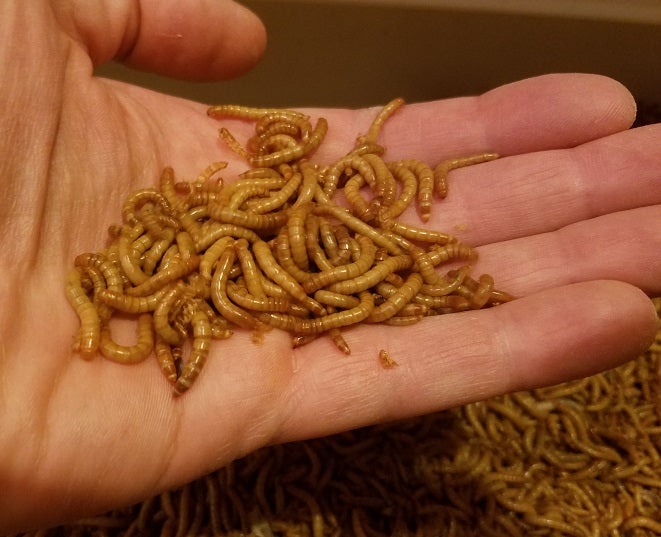
Regular observation of your feeder insects is essential for maintaining a clean, thriving colony.
By checking in frequently, you’ll be able to spot early signs of problems such as illness, contamination, or overcrowding. Sick or dead insects should be removed immediately to avoid spreading disease and spoiling the environment for the rest of the colony.
Pay close attention to their food and water situation. Hygiene plays a major role in insect health, so containers should be refreshed and cleaned regularly. Stale or moldy food attracts mites and bacteria that can wipe out your entire colony in a short time.
When dealing with Dubia roaches specifically, keeping track of their rapid breeding cycle is important. Young nymphs often need a separate space to thrive without being trampled or outcompeted by adults. Separating them ensures proper growth rates and reduces stress.
To make things easier, here are key health monitoring tasks to follow:
- Remove dead or sick insects daily to prevent contamination.
- Replace spoiled food and water before it molds.
- Clean containers and substrate on a regular basis.
- Separate nymphs from adults to maintain a balanced population.
- Observe behavior; sluggish movement or foul odor may indicate trouble.
A consistently healthy colony results in better-nourished feeder insects, which means healthier pets in turn.
6. Feeding Schedule and Care
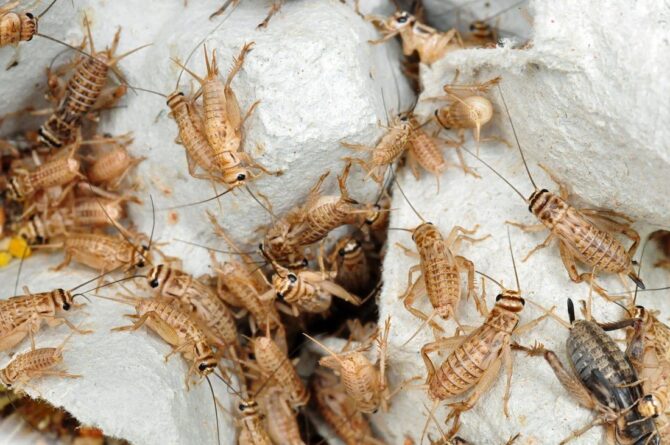
Caring for your feeder insects means keeping them well-fed and hydrated. While most species can be sustained by feeding every two to three days, conditions like temperature and humidity may speed up or slow down their metabolism.
Don’t just follow a clock—check their food daily and adjust based on consumption.
Feeder insects that are intended for reptiles should be nutritionally loaded before being offered as food. Gut-loading, which means feeding the insects a nutrient-rich diet for 24 to 48 hours, increases the value of every feeding session for your reptile. Think of it as prepping their food before the food becomes your pet’s food.
It’s especially important for common feeder insects such as Dubia roaches, mealworms, and superworms. Without gut-loading, your pet may miss out on essential vitamins and minerals.
Here’s a checklist to simplify your feeder care:
- Feed insects every 2–3 days, adjusting based on activity and food usage.
- Provide fresh fruits, vegetables, and commercial gut-load formulas.
- Keep a small water source like gel crystals to avoid drowning.
- Gut-load insects 24–48 hours before offering them to your reptile.
- Ensure feeders are an appropriate size for your pet’s safety and comfort.
A good feeding routine ensures your feeders stay alive longer, breed more, and deliver the best possible nutrition to your reptile.
Conclusion
Properly storing live feeder insects is crucial for maintaining their health and nutritional value for your pet reptiles. By maintaining the right temperature, providing adequate containers, ensuring proper food and humidity, and monitoring their health, you can create an optimal environment for your insects. Consistent care and attention will ensure that your feeder insects stay healthy and provide maximum benefits for your reptiles.
